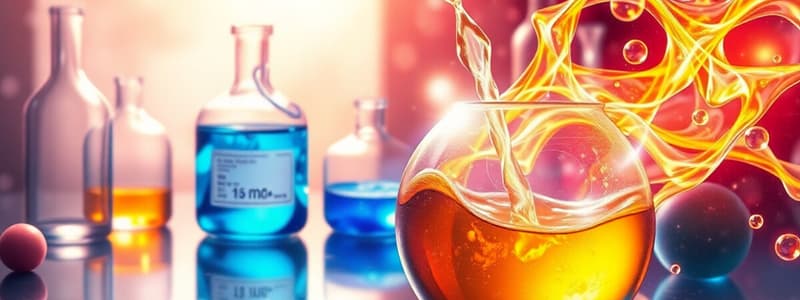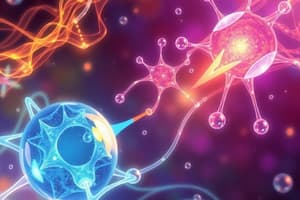Podcast
Questions and Answers
What distinguishes ionic compounds from molecular compounds?
What distinguishes ionic compounds from molecular compounds?
- Ionic compounds are formed only from nonmetals while molecular compounds can contain metals.
- Ionic compounds consist of charged particles while molecular compounds consist of neutral molecules. (correct)
- Ionic compounds have lower melting points than molecular compounds.
- Ionic compounds do not conduct electricity, while molecular compounds do.
Which of the following correctly describes the pH scale?
Which of the following correctly describes the pH scale?
- A pH of 7 indicates a weak acid.
- The pH scale ranges from 0 to 14, with lower numbers indicating basic substances.
- The pH scale indicates the concentration of hydroxide ions in a solution.
- The pH scale is logarithmic and reflects the concentration of hydrogen ions. (correct)
What is the correct process for naming an acid?
What is the correct process for naming an acid?
- For oxyacids, if the anion ends in 'ate', the acid name ends with 'ic'. (correct)
- Use the name of the anion and add 'acid' for all acids.
- Acids are named by the number of hydrogen ions they contain.
- For monoatomic anions, drop the suffix and add 'ate' followed by 'acid'.
In terms of subatomic particles, what characterizes a neutron?
In terms of subatomic particles, what characterizes a neutron?
Which type of reaction is characterized by the absorption of heat?
Which type of reaction is characterized by the absorption of heat?
What is a fundamental difference between scalars and vectors?
What is a fundamental difference between scalars and vectors?
When predicting products in a chemical reaction, one must...
When predicting products in a chemical reaction, one must...
In a distance-time graph, a horizontal line represents:
In a distance-time graph, a horizontal line represents:
Which are the three main points of the cell theory?
Which are the three main points of the cell theory?
What is primarily responsible for the differentiation between passive and active transport across the cell membrane?
What is primarily responsible for the differentiation between passive and active transport across the cell membrane?
In the context of plant biology, what are the two organ systems found in plants?
In the context of plant biology, what are the two organ systems found in plants?
Which process occurs primarily in the chloroplasts of plant cells?
Which process occurs primarily in the chloroplasts of plant cells?
How do xylem and phloem differ in their functions within plants?
How do xylem and phloem differ in their functions within plants?
What primarily contributes to the greenhouse effect?
What primarily contributes to the greenhouse effect?
What happens during phototropism in plants?
What happens during phototropism in plants?
Which factor does NOT impact the specific heat capacity of a substance?
Which factor does NOT impact the specific heat capacity of a substance?
Flashcards
What is distance?
What is distance?
Distance is the total length of the path an object travels. It is a scalar quantity, meaning it only has magnitude, not direction.
What is displacement?
What is displacement?
Displacement is the overall change in position of an object from its starting point to its end point. It is a vector quantity, meaning it has both magnitude and direction.
What is speed?
What is speed?
Speed is the rate at which an object moves, calculated by dividing the distance traveled by the time taken. It is a scalar quantity, meaning it only has magnitude.
What is velocity?
What is velocity?
Signup and view all the flashcards
What is acceleration?
What is acceleration?
Signup and view all the flashcards
What is work in Physics?
What is work in Physics?
Signup and view all the flashcards
What is potential energy?
What is potential energy?
Signup and view all the flashcards
What is kinetic energy?
What is kinetic energy?
Signup and view all the flashcards
Efficiency
Efficiency
Signup and view all the flashcards
Laws of Thermodynamics
Laws of Thermodynamics
Signup and view all the flashcards
Objective Lens
Objective Lens
Signup and view all the flashcards
Field of View
Field of View
Signup and view all the flashcards
Cell
Cell
Signup and view all the flashcards
Cell Theory
Cell Theory
Signup and view all the flashcards
Active Transport
Active Transport
Signup and view all the flashcards
Surface Area to Volume Ratio
Surface Area to Volume Ratio
Signup and view all the flashcards
Study Notes
Chemistry
- Matter & the periodic table:
- Atomic models (scientists and characteristics, no dates)
- Subatomic particles and characteristics
- Important groups and their characteristics
- Diatomic and polyatomic elements
- Compounds:
- Covalent and ionic bond formation
- Comparison of ionic and molecular compounds
- Naming ionic and molecular compounds
- Acids and bases (and solubility):
- pH scale
- Properties of acids and bases
- Naming acids
- Acid-base indicators
- Solubility of ionic compounds (using the solubility table)
- Mole calculations:
- Conversions between grams and moles (g↔mol)
- Conversions between moles and atoms/molecules (mol↔atoms/molecules)
- Reactions:
- Evidence of chemical reactions
- Types of reactions (and how to identify them)
- Endothermic vs. exothermic reactions
- Predicting products and writing chemical equations
- Balancing chemical equations
- Mole ratio for predicting moles of reactants/products
Physics
- Definitions:
- Difference between scalar and vector quantities, examples
- Kinematics:
- Calculate distance and displacement
- Calculate speed and velocity
- Calculate acceleration
- Graphs (distance-time, velocity-time, acceleration-time) for uniform and accelerated motion
- Energetics:
- Calculating work (force must be in same direction as movement) -Calculating work from distance-time graphs
- Calculating potential and kinetic energy
- Energy conversions in situations like objects falling, pendulums, and roller coasters
- Total mechanical energy does not change
- Calculate energy efficiency.
- Relate concepts to thermodynamic laws
Biology
- Microscopes:
- Parts of a light microscope and functions
- Microscope calculations (high power, field of view, specimen size)
- Cell theory:
- Three points of the cell theory
- Cell organization
- Plant and animal cells:
- Cell organelles and their functions
- Comparison of plant and animal cells
- Cell membrane:
- Fluid mosaic model
- Active and passive transport
- Tonicity
- Surface area to volume:
- Relationship between surface area, volume and cell efficiency
- Plant structure:
- Two organ systems, three tissue systems
- Gas transport:
- Photosynthesis vs cellular respiration (reactions, where when)
- Water and sugar (xylem and phloem) transport, properties (water, root pressure, transpiration pull)
- Plant tropisms:
- Positive and negative responses (phototropism, gravitropism)
- Global Systems (Heat Calculations):
- Calculations of specific heat, heat of fusion, and heat of vaporization.
- Heating curves of water
- Weather & Climate:
- Types of weather systems
- Types of heat transfer, albedo, greenhouse effect, and greenhouse gasses
- Interpret climatographs
- Adaptations in living organisms
- General knowledge of biomes
- Climate and weather terms from workbooks
Studying That Suits You
Use AI to generate personalized quizzes and flashcards to suit your learning preferences.
Related Documents
Description
Test your knowledge on the fundamental concepts of chemistry including atomic models, bonding, acids and bases, mole calculations, and chemical reactions. This quiz will cover various essential topics outlined in your chemistry curriculum, focusing on the periodic table, compounds, and more.




